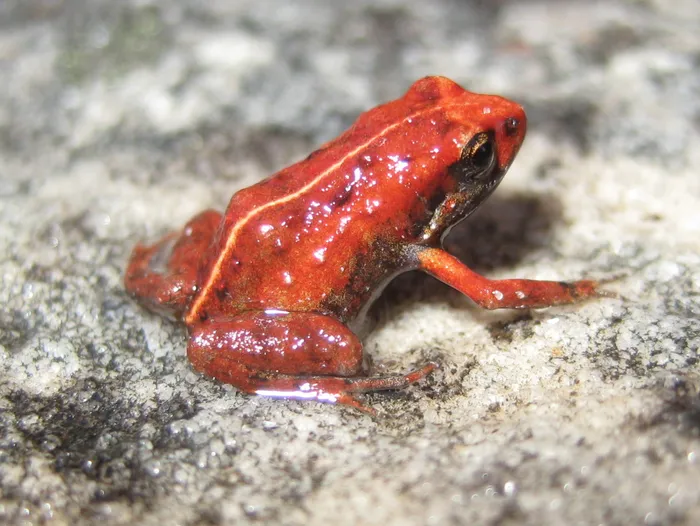SU researcher part of global study on extinction of amphibians

A Peninsula moss frog. The Amphibian Specialist Group (ASG) is part of the Species Survival Commission (SSC) of the International Union for Conservation of Nature (IUCN). It is a volunteer network of over 300 of the world’s leading amphibian experts providing the scientific foundation to inform effective amphibian conservation action around the world. Under the umbrella of the ASG, the Amphibian Red List Authority is the body responsible for overseeing the assessments of all amphibians on the IUCN Red List of Threatened Species. File image
Cape Town - A study has found that 40% of amphibians face extinction largely due to climate change, and a Stellenbosch University (SU) researcher contributed to the findings.
The study was published in the scientific journal “Nature” this week.
The study is based on the second amphibian assessment which is co-ordinated by the Amphibian Red List Authority.
This is a branch of the International Union for Conservation of Nature’s Species Survival Commission’s Amphibian Specialist Group, hosted and managed by Re:wild.
The assessment evaluated the extinction risk of more than 8 000 amphibian species from all over the world, including 2 286 species evaluated for the first time.
More than 1 000 experts across the globe contributed their data and expertise, which found that two out of every five amphibians are threatened with extinction.
It is said that between 2004 and 2022, critical threats have pushed more than 300 amphibians closer to extinction, according to the study.
Climate change was the primary threat for 39% of these species.
This number is expected to rise as better data and projections on species’ responses to climate change become available. Climate change is especially concerning for amphibians in large part because they are particularly sensitive to changes in their environment.
Professor John Measey of SU’s Centre for Invasion Biology was one of more than 100 international experts who contributed data and expertise to the study.
He was responsible for the southern African part of the project.
“IUCN (The International Union for Conservation of Nature) assessments are a key indicator to the conservation status of our regional amphibians and this assessment demonstrates their ongoing decline,” he explained.
“This study shows hot spots of disease in central and eastern African amphibians as an emerging concern for their conservation on the continent.
“The Red List Index suggests the ongoing decline of African amphibians, primarily driven by habitat loss, but most recently by disease.”
Jennifer Luedtke Swandby, Re:wild manager of species partnerships and Red List Authority co-ordinator of the IUCN SSC Amphibian Specialist Group, said fires and weather patterns were also a contributing factor.
“As humans drive changes in the climate and to habitats, amphibians are becoming climate captives, unable to move very far to escape the climate change-induced increase in frequency and intensity of extreme heat, wildfires, drought and hurricanes,” said Swandby, one of the lead authors of the study.
“Our study shows that we cannot continue to underestimate this threat.
“Protecting and restoring forests is critical not only to safeguarding biodiversity, but also to tackling climate change.”
The study further indicates that habitat destruction and degradation as the result of agriculture (including crops, livestock like cattle and livestock grazing, and silviculture), infrastructure development and other industries is still the most common threat.
Habitat destruction and degradation affect 93% of all threatened amphibian species. Expanded habitat and corridor protection in the places most important for biodiversity is going to continue to be critical.
The study also found that three out of every five salamander species are threatened with extinction primarily as the result of habitat destruction and climate change, making salamanders the world’s most threatened group of amphibians.
Four amphibian species were documented as having gone extinct since 2004 which included the Chiriquí harlequin toad (Atelopus chiriquiensis) from Costa Rica, the sharp snouted day frog (Taudactylus acutirostris) from Australia, Craugastor myllomyllon and the Jalpa false brook salamander (Pseudoeurycea exspectata), both from Guatemala. Twenty-seven additional critically endangered species are now considered possibly extinct, bringing the total to more than 160 critically endangered amphibians that are considered possibly extinct.
The assessment also found that 120 species improved their Red List status since 1980. Of the 63 species that improved as the direct result of conservation action, most improved due to habitat protection and management.
Conservationists will use the information from this study to help inform a global conservation action plan, to prioritise conservation actions at the global level, to seek additional resources, and to influence policy that can help reverse the negative trend for amphibians.
Related Topics: